You are using an out of date browser. It may not display this or other websites correctly.
You should upgrade or use an alternative browser.
You should upgrade or use an alternative browser.
Lowering & 4-wheel Laser Alignment - How I Done It -
- Thread starter Dellmassive
- Start date
Cgtmiles - your alignment guy is pulling a fast one. You should never compensate the toe in/out because of camber.
The rear camber on you van is in the green, even though it's towards the top limit. The toe in/out is the only thing adjustable and this could be corrected without changing the camber. It's the toe in/out which has the most effect on the performance, and you've double the required amount of toe in and this will scrub your tyres quickly. I would get it corrected.
The rear camber on you van is in the green, even though it's towards the top limit. The toe in/out is the only thing adjustable and this could be corrected without changing the camber. It's the toe in/out which has the most effect on the performance, and you've double the required amount of toe in and this will scrub your tyres quickly. I would get it corrected.
@cgtmiles you must get it re-done or you are going to destroy your rear tyres in no time, trust me, I've been there! @Littleblackflash is spot on. Excessive toe in is going to wear the outer edges and tread of your tyres in about 3000 - 4000 miles with those toe numbers. Camber does not affect the wear on a T6 anything like as much as the toe. I would bin that alignment guy off and find someone who knows what they're talking about.
I'll also try and explain why you must use the "No Load" settings.....
When you have an alignment done using "half" or "full" load, the machine assumes that you are carrying more load than you normally would be, so it assumes that your van is sitting lower than it normally would. The outcome of this is that it adjusts the target "green" numbers to those for a van sitting higher than yours is.
As you lower a T6 and especially on the rear end you will get toe in and negative camber. This is simply because of the geometry of the rear arms and their mounting points.
So, the machine thinks your van is sitting lower than it normally would and adjusts the target numbers to be that for a van sitting higher, it thinks that your wheels don't usually toe in as much as they are and so it doesn't ask the fitter to correct them (as much as it should). It will allow that number to go green when they are still toeing in, assuming that when you get home and take the load out of the van it will sit higher and the toe in will reduce to correct settings. What it doesn't know is that you aren't taking any load out of the van at all, so your suspension geometry doesn't change, the wheels continue to toe in too much and you ruin your rear tyres in no time!
When you have it done with "no load" settings, the machine sets the target numbers assuming that your van runs at it's current ride height and therefore suspension geometry all the time. That means it uses the correct targets for how your van is sitting at the time of the alignment. That gives a toe in target much closer to 0 and makes sure that you get the alignment you need to look after your tyres correctly. This becomes more and more critical the lower your van goes, simply because the lower you go, the further the wheels will toe in until there is no adjustment left.
I'm about 80-85mm down and on the limit of the rear toe settings, there's no adjustment left and they are only just in tolerance on the "no load" settings. I suspect I'll still wear my rear tyres more quickly than I would like, but not as bad as the last ones. When these are worn and I get them replaced, I'll have some adjustable poly bushes fitted to help adjust the toe a bit further.
I hope that explains it, I've done my best!!
I'll also try and explain why you must use the "No Load" settings.....
When you have an alignment done using "half" or "full" load, the machine assumes that you are carrying more load than you normally would be, so it assumes that your van is sitting lower than it normally would. The outcome of this is that it adjusts the target "green" numbers to those for a van sitting higher than yours is.
As you lower a T6 and especially on the rear end you will get toe in and negative camber. This is simply because of the geometry of the rear arms and their mounting points.
So, the machine thinks your van is sitting lower than it normally would and adjusts the target numbers to be that for a van sitting higher, it thinks that your wheels don't usually toe in as much as they are and so it doesn't ask the fitter to correct them (as much as it should). It will allow that number to go green when they are still toeing in, assuming that when you get home and take the load out of the van it will sit higher and the toe in will reduce to correct settings. What it doesn't know is that you aren't taking any load out of the van at all, so your suspension geometry doesn't change, the wheels continue to toe in too much and you ruin your rear tyres in no time!
When you have it done with "no load" settings, the machine sets the target numbers assuming that your van runs at it's current ride height and therefore suspension geometry all the time. That means it uses the correct targets for how your van is sitting at the time of the alignment. That gives a toe in target much closer to 0 and makes sure that you get the alignment you need to look after your tyres correctly. This becomes more and more critical the lower your van goes, simply because the lower you go, the further the wheels will toe in until there is no adjustment left.
I'm about 80-85mm down and on the limit of the rear toe settings, there's no adjustment left and they are only just in tolerance on the "no load" settings. I suspect I'll still wear my rear tyres more quickly than I would like, but not as bad as the last ones. When these are worn and I get them replaced, I'll have some adjustable poly bushes fitted to help adjust the toe a bit further.
I hope that explains it, I've done my best!!
Note the two images below, both taken from other posts in this thread. Look at the Rear Toe setting tolerances. One has a toe in limit of 25 minutes, the other has a limit of 15 minutes. The 25 is the "half load" target, the 15 is the "no load" target. The top image shows that 22 minutes is acceptable, but it wouldn't be if your van is lowered and the load doesn't change, the toe in would stay at 22 minutes and wear the outer edge/tread prematurely. That would fail if the machine had been set to "no load" and correctly so. That illustrates what I have said in my previous post. A much tighter target. Just in case anyone reading this doesn't understand the minutes, it's 1/60th of a degree.@cgtmiles you must get it re-done or you are going to destroy your rear tyres in no time, trust me, I've been there! @Littleblackflash is spot on. Excessive toe in is going to wear the outer edges and tread of your tyres in about 3000 - 4000 miles with those toe numbers. Camber does not affect the wear on a T6 anything like as much as the toe. I would bin that alignment guy off and find someone who knows what they're talking about.
I'll also try and explain why you must use the "No Load" settings.....
When you have an alignment done using "half" or "full" load, the machine assumes that you are carrying more load than you normally would be, so it assumes that your van is sitting lower than it normally would. The outcome of this is that it adjusts the target "green" numbers to those for a van sitting higher than yours is.
As you lower a T6 and especially on the rear end you will get toe in and negative camber. This is simply because of the geometry of the rear arms and their mounting points.
So, the machine thinks your van is sitting lower than it normally would and adjusts the target numbers to be that for a van sitting higher, it thinks that your wheels don't usually toe in as much as they are and so it doesn't ask the fitter to correct them (as much as it should). It will allow that number to go green when they are still toeing in, assuming that when you get home and take the load out of the van it will sit higher and the toe in will reduce to correct settings. What it doesn't know is that you aren't taking any load out of the van at all, so your suspension geometry doesn't change, the wheels continue to toe in too much and you ruin your rear tyres in no time!
When you have it done with "no load" settings, the machine sets the target numbers assuming that your van runs at it's current ride height and therefore suspension geometry all the time. That means it uses the correct targets for how your van is sitting at the time of the alignment. That gives a toe in target much closer to 0 and makes sure that you get the alignment you need to look after your tyres correctly. This becomes more and more critical the lower your van goes, simply because the lower you go, the further the wheels will toe in until there is no adjustment left.
I'm about 80-85mm down and on the limit of the rear toe settings, there's no adjustment left and they are only just in tolerance on the "no load" settings. I suspect I'll still wear my rear tyres more quickly than I would like, but not as bad as the last ones. When these are worn and I get them replaced, I'll have some adjustable poly bushes fitted to help adjust the toe a bit further.
I hope that explains it, I've done my best!!
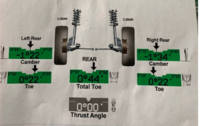
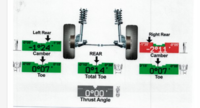
Thanks! I can go to the garage armed with a bit more info now and hopefully get it done right. Will report back.@cgtmiles you must get it re-done or you are going to destroy your rear tyres in no time, trust me, I've been there! @Littleblackflash is spot on. Excessive toe in is going to wear the outer edges and tread of your tyres in about 3000 - 4000 miles with those toe numbers. Camber does not affect the wear on a T6 anything like as much as the toe. I would bin that alignment guy off and find someone who knows what they're talking about.
I'll also try and explain why you must use the "No Load" settings.....
When you have an alignment done using "half" or "full" load, the machine assumes that you are carrying more load than you normally would be, so it assumes that your van is sitting lower than it normally would. The outcome of this is that it adjusts the target "green" numbers to those for a van sitting higher than yours is.
As you lower a T6 and especially on the rear end you will get toe in and negative camber. This is simply because of the geometry of the rear arms and their mounting points.
So, the machine thinks your van is sitting lower than it normally would and adjusts the target numbers to be that for a van sitting higher, it thinks that your wheels don't usually toe in as much as they are and so it doesn't ask the fitter to correct them (as much as it should). It will allow that number to go green when they are still toeing in, assuming that when you get home and take the load out of the van it will sit higher and the toe in will reduce to correct settings. What it doesn't know is that you aren't taking any load out of the van at all, so your suspension geometry doesn't change, the wheels continue to toe in too much and you ruin your rear tyres in no time!
When you have it done with "no load" settings, the machine sets the target numbers assuming that your van runs at it's current ride height and therefore suspension geometry all the time. That means it uses the correct targets for how your van is sitting at the time of the alignment. That gives a toe in target much closer to 0 and makes sure that you get the alignment you need to look after your tyres correctly. This becomes more and more critical the lower your van goes, simply because the lower you go, the further the wheels will toe in until there is no adjustment left.
I'm about 80-85mm down and on the limit of the rear toe settings, there's no adjustment left and they are only just in tolerance on the "no load" settings. I suspect I'll still wear my rear tyres more quickly than I would like, but not as bad as the last ones. When these are worn and I get them replaced, I'll have some adjustable poly bushes fitted to help adjust the toe a bit further.
I hope that explains it, I've done my best!!
Ok so yesterday I went back to the same place I went to before and the guy was still insisting that having toe in was the correct thing to do to account for the increased camber. He did adjust it though but gave a serious warning that I should check the tyres regularly as he believed they would now scrub on the inside edge.
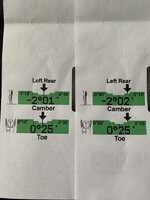
So this is what he did, he brought the toe down to around 25’ from 35’. The images above are left=full load, right=half load.
Now what he explained about loading was that as the camber is out because of the lowering the van is always sitting at that camber and therefore the full load settings should be used, this makes sense to me. The toe etc specs change as the camber specs change so in full load (which with full conversion and most of the gear onboard it pretty much is all the time anyway) the camber is as expected and can’t be adjusted so the full load specs should be used for toe too.
I have RTEC nearby who are specialist in custom vehicles and also run a lowered T5 so I’m going to put this to them also but I just wanted to get your thoughts on this first.
The responses on here are pretty much agreed that the toe should not be adjusted to account for the camber but he was actually quite concerned that this would damage the tyres so it’s interesting that if he’s wrong then his thinking is almost 180degrees out! And I still have high toe going by the no load settings! I wanted to give them another go and they are normally good (did do the adjustment for free so I’ve just lost a bit of time if I need to go elsewhere!)

So this is what he did, he brought the toe down to around 25’ from 35’. The images above are left=full load, right=half load.
Now what he explained about loading was that as the camber is out because of the lowering the van is always sitting at that camber and therefore the full load settings should be used, this makes sense to me. The toe etc specs change as the camber specs change so in full load (which with full conversion and most of the gear onboard it pretty much is all the time anyway) the camber is as expected and can’t be adjusted so the full load specs should be used for toe too.
I have RTEC nearby who are specialist in custom vehicles and also run a lowered T5 so I’m going to put this to them also but I just wanted to get your thoughts on this first.
The responses on here are pretty much agreed that the toe should not be adjusted to account for the camber but he was actually quite concerned that this would damage the tyres so it’s interesting that if he’s wrong then his thinking is almost 180degrees out! And I still have high toe going by the no load settings! I wanted to give them another go and they are normally good (did do the adjustment for free so I’ve just lost a bit of time if I need to go elsewhere!)
@cgtmiles you must get that toe corrected
I understand the theory to which your fitter is working and can follow the logic. I would love to agree with him, but then we would both be wrong.
Camber and toe are linked, yes, and when you adjust one it can affect the other. On these vans the camber on the rear is not as much of an issue as the toe. There are so many members on this forum who have struggled with rear tyre wear because of toe, there really are. Excessive rear toe in will scrub the outer tread of the tyres in no time, I'm not saying that for a joke, it's a well documented problem with lowered T6 vans.
It has also been established and shared amongst members that the correct settings to use for a lowered van are "no load" regardless of whether you are an empty kombi or a loaded camper. If the load stays the same you must use "No Load" settings. As I explained yesterday, if you don't, the machine uses different (wider) targets, because it expects the load to be removed in normal running. Note that in your images, the tolerance for the camber is wider in the "full load" image than the "half load" image, this goes directly against what your fitter is saying. The "full load" settings would allow the camber to be much worse than the "half load" or "no load" settings, because it's expecting the camber to improve when you remove the load and the van returns to it's normal ride height.
You are never removing your load! "no load" gives tighter tolerances to ensure the wheel alignment is set correctly for a van that will run with a constant load for the majority of the time. If you run with a full load all the time you still have to use "no load" settings.
The only time you would use "full load" or "half load" is if your van is usually empty, but at the time of having the alignment you happened to have some load in the van. That way the machine will compensate with its targets accordingly.
I would never intentionally mislead a forum member, I only ever post what I believe to be true and there are many other members who have struggled with rear wear and have solved it by using "no load" settings when having the alignment done. It's all about the toe in values.
For reference, I have had my rear tyres on for a couple of thousand miles now since having my alignment done with "no load" settings. I have noticeable negative camber, you can see it by eye, which is what your fitter is advising against (although the wider tolerance band of "full load" allows it!), but that is not something that can be adjusted with the standard rear suspension components, it is what it is. I have measured the wear across the tyres this morning and it is equal across the entire tyre with 0.1mm accuracy.
When I ran with toe in numbers not a million miles away from the 25 minutes yours is set at my tyres lasted 4000 miles. The outer tread was gone, almost through to the reinforcement, but I still had 5mm left on the inside and 3mm left in the middle, despite my negative camber!! All we changed at the following alignment was the toe. We got a more neutral rear toe, rather than excessive toe in and problem solved.
I'm really sorry, but your fitter is wrong. Sorry if this sounds argumentative, I'm not trying to upset anyone, I'm trying to help you avoid the same problems that many other members have experienced.
I haven't suggested adjusting the toe to account for camber, I was suggesting adjusting the toe to save your tyres.Ok so yesterday I went back to the same place I went to before and the guy was still insisting that having toe in was the correct thing to do to account for the increased camber. He did adjust it though but gave a serious warning that I should check the tyres regularly as he believed they would now scrub on the inside edge.
View attachment 73421
So this is what he did, he brought the toe down to around 25’ from 35’. The images above are left=full load, right=half load.
Now what he explained about loading was that as the camber is out because of the lowering the van is always sitting at that camber and therefore the full load settings should be used, this makes sense to me. The toe etc specs change as the camber specs change so in full load (which with full conversion and most of the gear onboard it pretty much is all the time anyway) the camber is as expected and can’t be adjusted so the full load specs should be used for toe too.
I have RTEC nearby who are specialist in custom vehicles and also run a lowered T5 so I’m going to put this to them also but I just wanted to get your thoughts on this first.
The responses on here are pretty much agreed that the toe should not be adjusted to account for the camber but he was actually quite concerned that this would damage the tyres so it’s interesting that if he’s wrong then his thinking is almost 180degrees out! And I still have high toe going by the no load settings! I wanted to give them another go and they are normally good (did do the adjustment for free so I’ve just lost a bit of time if I need to go elsewhere!)
I understand the theory to which your fitter is working and can follow the logic. I would love to agree with him, but then we would both be wrong.
Camber and toe are linked, yes, and when you adjust one it can affect the other. On these vans the camber on the rear is not as much of an issue as the toe. There are so many members on this forum who have struggled with rear tyre wear because of toe, there really are. Excessive rear toe in will scrub the outer tread of the tyres in no time, I'm not saying that for a joke, it's a well documented problem with lowered T6 vans.
It has also been established and shared amongst members that the correct settings to use for a lowered van are "no load" regardless of whether you are an empty kombi or a loaded camper. If the load stays the same you must use "No Load" settings. As I explained yesterday, if you don't, the machine uses different (wider) targets, because it expects the load to be removed in normal running. Note that in your images, the tolerance for the camber is wider in the "full load" image than the "half load" image, this goes directly against what your fitter is saying. The "full load" settings would allow the camber to be much worse than the "half load" or "no load" settings, because it's expecting the camber to improve when you remove the load and the van returns to it's normal ride height.
You are never removing your load! "no load" gives tighter tolerances to ensure the wheel alignment is set correctly for a van that will run with a constant load for the majority of the time. If you run with a full load all the time you still have to use "no load" settings.
The only time you would use "full load" or "half load" is if your van is usually empty, but at the time of having the alignment you happened to have some load in the van. That way the machine will compensate with its targets accordingly.
I would never intentionally mislead a forum member, I only ever post what I believe to be true and there are many other members who have struggled with rear wear and have solved it by using "no load" settings when having the alignment done. It's all about the toe in values.
For reference, I have had my rear tyres on for a couple of thousand miles now since having my alignment done with "no load" settings. I have noticeable negative camber, you can see it by eye, which is what your fitter is advising against (although the wider tolerance band of "full load" allows it!), but that is not something that can be adjusted with the standard rear suspension components, it is what it is. I have measured the wear across the tyres this morning and it is equal across the entire tyre with 0.1mm accuracy.
When I ran with toe in numbers not a million miles away from the 25 minutes yours is set at my tyres lasted 4000 miles. The outer tread was gone, almost through to the reinforcement, but I still had 5mm left on the inside and 3mm left in the middle, despite my negative camber!! All we changed at the following alignment was the toe. We got a more neutral rear toe, rather than excessive toe in and problem solved.
I'm really sorry, but your fitter is wrong. Sorry if this sounds argumentative, I'm not trying to upset anyone, I'm trying to help you avoid the same problems that many other members have experienced.
I’m sorry, I didn’t mean to question your knowledge on this I’m just trying to get it straight in my head. It is very difficult when they are saying the complete opposite to argue against them without truly understanding. I really appreciate your input and the efforts you have gone to to try and get this through my thick skull! 
On that note (ie. my thick skull) you mentioned outside wear, I thought the wear would be on the inside? The excessive toe means the front of the wheels are pointing towards the centre of the van more than they should right? And with them leaning in at the top wouldn’t the wear be on the inside? This is where the fitter thought they would wear too. This question may help you understand what your dealing with here, sorry again if it’s a daft assumption

On that note (ie. my thick skull) you mentioned outside wear, I thought the wear would be on the inside? The excessive toe means the front of the wheels are pointing towards the centre of the van more than they should right? And with them leaning in at the top wouldn’t the wear be on the inside? This is where the fitter thought they would wear too. This question may help you understand what your dealing with here, sorry again if it’s a daft assumption
I'll knock a couple of quick sketches together to try and illustrate why the wear is on the outside because of the toe and I'll post em up in a minute.I’m sorry, I didn’t mean to question your knowledge on this I’m just trying to get it straight in my head. It is very difficult when they are saying the complete opposite to argue against them without truly understanding. I really appreciate your input and the efforts you have gone to to try and get this through my thick skull!
On that note (ie. my thick skull) you mentioned outside wear, I thought the wear would be on the inside? The excessive toe means the front of the wheels are pointing towards the centre of the van more than they should right? And with them leaning in at the top wouldn’t the wear be on the inside? This is where the fitter thought they would wear too. This question may help you understand what your dealing with here, sorry again if it’s a daft assumption

You don’t have to do that, very kind offer though, again thx for your time.
Interesting again though that he was concerned on wear on the inside edge or maybe I just made that assumption. Anyway, I will get it done with no load elsewhere.
Again, I very much appreciate the time and fort you have gone to to explain this to me. I definitely owe you a beer (at least one) if ever we meet!
Interesting again though that he was concerned on wear on the inside edge or maybe I just made that assumption. Anyway, I will get it done with no load elsewhere.
Again, I very much appreciate the time and fort you have gone to to explain this to me. I definitely owe you a beer (at least one) if ever we meet!
I'm booked in at tuned uk tomorrow for the 4 wheel alignment thanks to fezza.... I'm pretty sure these guys know what they're doing... but I have one of the print offs which shows the 'no load' settings and i think the main point i can gather from this subject is to ask for neutral rear toe.
I agree, in theory excessive negative camber should lead to wear on the inside edge as it's that edge taking more load, fair enough, that makes sense, but it needs to be seriously excessive. When it comes to toe it's about direction of tyre rotation vs direction the van is travelling in.You don’t have to do that, very kind offer though, again thx for your time.
Interesting again though that he was concerned on wear on the inside edge or maybe I just made that assumption. Anyway, I will get it done with no load elsewhere.
Again, I very much appreciate the time and fort you have gone to to explain this to me. I definitely owe you a beer (at least one) if ever we meet!
If the van has excessive toe in you get the following scenario: Imagine the van is moving forwards in a straight line, the tyre needs to do the same, but because it is facing in towards the centre of the van, it rotates in that direction, not straight forwards in the same direction as the van. The outside edge is the furthest edge forward, so takes most of the punishment as the tyre effectively scrubs along the road rather than rotating along it in harmony.
If the van has excessive camber, but neutral toe, the tyre will run directly along the direction of travel of the van, so you may get slightly more wear on the inner edge due to it taking most load, but it's negligible because the tyre is running true to the direction of travel, rather than scrubbing.
With excessive toe in and a little bit of negative camber, the effects of the scrubbing due to the toe in far outweigh the effects of the camber.
With camber, the tyre itself can compensate a bit, it isn't solid, so it will deform across it's section to ensure that the tyre is sitting pretty flat on the road surface, negating some of the negative camber anyway.
With excessive toe in, the tyre can't do anything to help itself, it just sits there with it's leading outside edge getting battered as it scrubs it's way along the road rather than rotating along it as it should.
I'm having the front and rear adjustable poly bushes fitted next week @BognorMotors.
It's all very confusing with people all doing the same thing but with different ways of getting there.
I asked my local Protyre to set my van up with 'no load settings' back in March and got the below on the print out, but it doesn't mean anything to me.
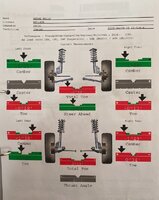
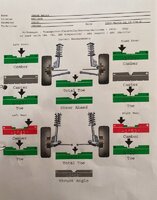
It's all very confusing with people all doing the same thing but with different ways of getting there.
I asked my local Protyre to set my van up with 'no load settings' back in March and got the below on the print out, but it doesn't mean anything to me.


I have just spoken to R-Tec, a custom car specialist in St Albans and they knew straight away what I was on about so I have it booked in for tomorrow.
Thanks again
Following this to see how you get on, as probably should get mine checked too, but seems a minefield out there having read through this thread.
I'm in West Oxfordshire but willing to travel a reasonable distance based on recommendations for decent knowledgeable peeps to do my 4 wheel alignment, if anyone has any feedback of "local" places to me. Thanks very much.
Just found these guys, only an hour from me, anyone used them?
Just found these guys, only an hour from me, anyone used them?

Hunter Wheel Alignment Recommendations in Herts/Beds/Bucks
Hi Just got an alignment done at my local tyre centre and although they have been good over the years for my basic tyre requirements it seems doing an alignment on a customised vehicle may be a bit beyond their abilities! So does anyone have any suggestions for places to go for hunter...
I can’t help you there I’m afraid, I started this thread for Herts/Beds/Bucks but didn’t get any responses.
If anyone has any recommendations then please add to this thread, thx
How did it go?I'm booked in at tuned uk tomorrow for the 4 wheel alignment thanks to fezza.... I'm pretty sure these guys know what they're doing... but I have one of the print offs which shows the 'no load' settings and i think the main point i can gather from this subject is to ask for neutral rear toe.
Thanks
How did it go?
Thanks
Hi, Yes, It seemed to go well at Tuned UK
He's a decent guy, with a quality professional set up and seems to know his stuff.
I had said that from the homework I had done I needed the 'no load' setting and a 'neutral' rear toe. He agreed that this was correct and that the front set up should be a 'parallel' set up. His system isn't a Hunter alignment one, but a more advanced system called 'Absolute Alignment' Absolute Alignment 4-Wheel Alignment Equipment
The drive back felt much better, but that wouldn't of been hard as the geometry was quite a way out to start with... The van felt more planted to the road, more grippy, but also more responsive. There was a noticeable reduction in drift to the left and once on the motorway, it was straight as an arrow.
I have to bow to his superior knowledge that he has set this up correctly, I understand there are lots of differing views over this subject on this forum.
He did say that 0.3mm toe was as good as he could get it on the rear without the adjustable poly bushes... but such a small amount wasn't going to effect driveabilty or tyre wear significantly. However I will keep an eye on this over the coming months.
Here are the before and after reports....
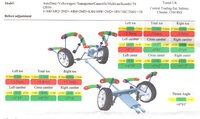
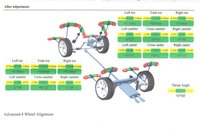
Last edited:
Similar threads
- Replies
- 6
- Views
- 2K
- Replies
- 8
- Views
- 2K
- Replies
- 8
- Views
- 3K
